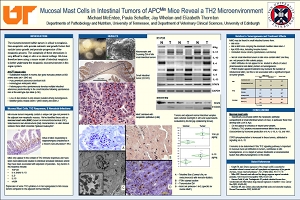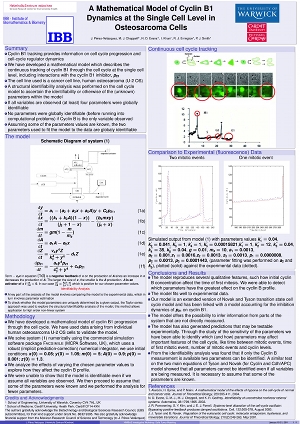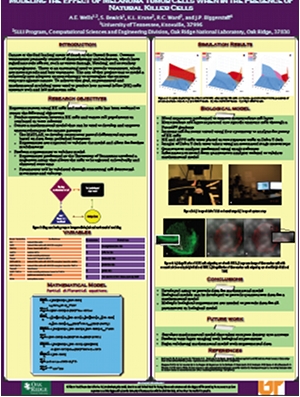| Description | Participants | Agenda | Summary | Products | Posters |
|---|
NIMBioS Investigative Workshop: Solid Tumor Modeling
Virtual Poster Session
NIMBioS Investigative Workshop on Solid Tumor Modeling held January 19-21, 2011. Posters are related to the workshop topic: Future Directions in Biophysically Accurate, Fully Three-Dimensional Solid Tumor Modeling: Biological, Computational and Clinical Challenges. Click on the link or image to view/download posters.
 Authors:
Haijun Gong1, Paolo Zuliani1, Qinsi Wang1, Anvesh Komuravelli1, James Faeder2, Michael Lotze2, Edmund Clarke 1
Authors:
Haijun Gong1, Paolo Zuliani1, Qinsi Wang1, Anvesh Komuravelli1, James Faeder2, Michael Lotze2, Edmund Clarke 1
Institutions:
(1) Computer Science Department, Carnegie Mellon University, Pittsburgh;
(2) University of Pittsburgh
Title:
Simulation and Model Checking of HMGB1 Signaling Pathway in Cancer
Abstract:
High-mobility group box-1 (HMGB1) protein has been recently shown to be associated with the cell
proliferation of various types of cancers. The protein HMGB1 can activate a number of signaling
networks – p53, NFkB, Ras and Rb pathways – which control many physiological processes of the
cell. We propose a rule-based model and a Boolean model of the HMGB1-p53-NFkB-Ras-Rb
network to investigate how these couplings influence proliferation and apoptosis of cancer cells. The
rule based model was implemented using the BioNetGen language which can
simulate both ordinary
differential equations and Gillespie's stochastic simulation algorithm. Then, we analyzed and verified
qualitative properties of the model by means of simulations and statistical model checking. For
Boolean network model, Symbolic Model Checking is applied to query and verify some temporal
logic properties of HMGB1 model.
Our simulations show that, if HMGB1 is overexpressed, the expression level of oncoproteins
CyclinD/E, which regulate cell proliferation, are upregulated, while tumor suppressor proteins which
regulate cell apoptosis, such as p53, are repressed. The discrete, stochastic simulations show that
HMGB1-activated receptors can generate sustained oscillations of irregular amplitude for the p53,
MDM2 and NFkB proteins. Moreover, the models predict that mutation or overexpression of RAS,
ARF, p21 and IkB kinase could influence the cancer cell's fate -- apoptosis or survival -- through the
crosstalk of different pathways. Our work shows that computational modeling and model checking
can be effectively combined in the study of biological signaling pathways.
Click here to view/download poster.
 Authors: Andrea Hawkins-Daarud1, Serge Prudhomme1, Kristoffer G. van der Zee2, J. Tinsley Oden1
Authors: Andrea Hawkins-Daarud1, Serge Prudhomme1, Kristoffer G. van der Zee2, J. Tinsley Oden1
Institutions:
(1) Institute for Computational Engineering and Sciences (ICES), The University of Texas at Austin;
(2) Department of Mechanical Engineering, Eindhoven University of Technology
Title: Bayesian Calibration, Validation, and Uncertainty Quantification of Diffuse Interface Models of Tumor Growth
Abstract:
Goal: Lay out a framework based on Bayesian probability for systematically addressing the questions of Validation (the process of investigating the capability of a mathematical model to reproduce particular physical events) and Uncertainty Quantification (developing measures of the degree of confidence in computer model predictions of quantities of interest) for Tumor Growth Models.
Click here to view/download poster.
 Authors:
Michael McEntee, Paula Schaffer, Jay Whelan and Elizabeth Thornton
Authors:
Michael McEntee, Paula Schaffer, Jay Whelan and Elizabeth Thornton
Institutions:
Departments of Pathobiology and Nutrition, Univ. of Tennessee; Department of Veterinary Clinical Sciences, Univ. of Edinburgh
Title:
Mucosal Mast Cells in Intestinal Tumors of APCMin Mice Reveal a TH2 Microenvironment
Abstract:
The microenvironment within tumors is critical to neoplasia. Non-neoplastic cells provide nutrients and growth factors that sustain tumor growth and promote progression of the neoplastic process. The complexity of these interactions is very difficult to study in vitro or in clinical settings. We have therefore been using a mouse model of intestinal neoplasia to better understand the neoplastic microenvironment in this organ system.
APCMIN Mouse (Min)
•
Substitution mutation in murine Apcgene truncates protein at 850 amino acids (wt = 2843 aa)
•
Fully penetrant autosomal dominant trait
•
Homozygous embryonic lethal
•
Heterozygous mice spontaneously develop multiple intestinal adenomas predominantly in the small intestine following spontaneous loss of the wild-type Apcallele (LOH)
•
Loss of Apcproduct is only known mutation driving tumorigenesis
•
Modifier genes include Mom-1(AKR strain) and Mom-2
Click here to view/download poster.
 Authors: J. Pérez-Velázquez1, M. J. Chappell2, N. D. Evans2, I. Khan3, R. J. Errington3, P. J. Smith3
Authors: J. Pérez-Velázquez1, M. J. Chappell2, N. D. Evans2, I. Khan3, R. J. Errington3, P. J. Smith3
Institutions:
(1) Institute of Biomathematics and Biometry (BBB), Neuherberg/Munich, German Research Center for Enviromental Health;
(2) School of Engineering, University of Warwick, Coventry, UK;
(3) School of Medicine, Cardiff University, Heath Park, Cardiff
Title:
A Mathematical Model of Cyclin B1 Dynamics at the Single Cell Level in Osteosarcoma Cells
Abstract:
Cyclin B1 tracking provides information on cell cycle progression and cell-cycle regulator dynamics. We have developed a mathematical model which describes the continuous tracking of cyclin B1 through the cell cycle at the single cell level, including interactions with the cyclin B1 inhibitor, p21. The cell line used is a cancer cell line, human osteosarcoma (U-2 OS). A structural identifiability analysis was performed on the cell cycle model to ascertain the identifiability or otherwise of the (unknown) parameters within the model. If all variables are observed (at least) four parameters were globally identifiable. No parameters were globally identifiable (before running into computational problems) if Cyclin B is the only variable observed. Assuming some of the parameter values are known, the two parameters used to fit the model to the data are globaly identifiable.
Click here to view/download poster.
 Authors:
A.E. Wells1,2, S. Bewick1, K.L. Kruse2, R.C. Ward2, and J.P. Biggerstaff1
Authors:
A.E. Wells1,2, S. Bewick1, K.L. Kruse2, R.C. Ward2, and J.P. Biggerstaff1
Institutions:
(1) University of Tennessee, Knoxville;
(2) SULI Program, Computational Sciences and Engineering Division, Oak Ridge National Laboratory
Title:
Modeling the Effect of Melanoma Tumor Cells When in the Presence of Natural Killer Cells
Abstract:
Cancer is the 2nd leading cause of death in the United States. Current treatments primarily consist of chemotherapy and radiation, which have significant side effects, such as tissue damage, bleeding, and secondary carcinogenesis. There is an increasing need to provide treatments, which are more specific and less traumatic. The aim of this project was to model a relatively new adoptive immunotherapy to investigate the immune response against cancer. To achieve this goal, experimental and mathematical modeling were used to predict how natural killer (NK) cells interact with and kill melanoma cells.
Click here to view/download poster.
Note that the work presented in most posters on this site is preliminary in nature and has not been peer reviewed. We suggest using Adobe Acrobat Reader® version 8 or higher to view these files. Using earlier version may result in errors when trying to open the documents.
NIMBioS
1122 Volunteer Blvd., Suite 106
University of Tennessee
Knoxville,
TN 37996-3410
PH: (865) 974-9334
FAX: (865) 974-9461
Contact NIMBioS


